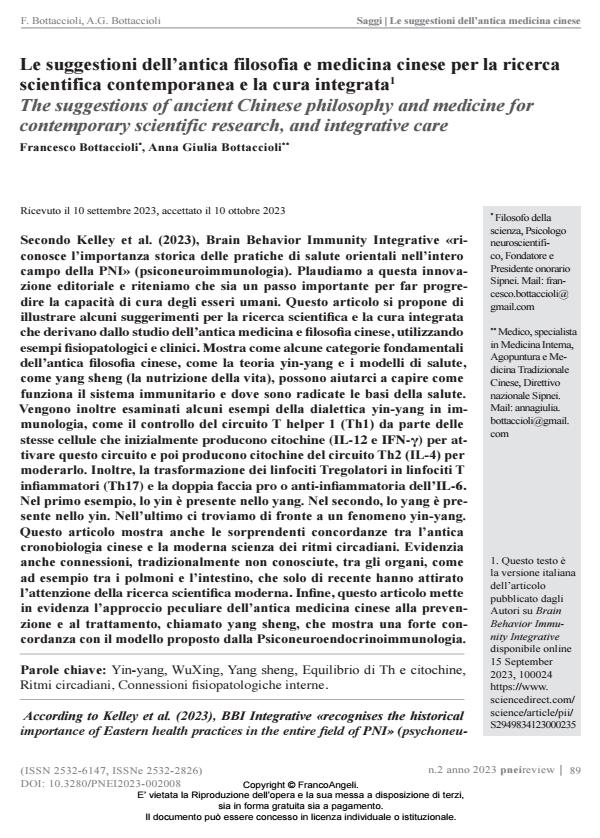The suggestions of ancient Chinese philosophy and medicine for contemporary scientific research, and integrative care
Journal title PNEI REVIEW
Author/s Francesco Bottaccioli, Anna Giulia Bottaccioli
Publishing Year 2023 Issue 2023/2 Language Italian
Pages 21 P. 89-109 File size 1270 KB
DOI 10.3280/PNEI2023-002009
DOI is like a bar code for intellectual property: to have more infomation
click here
Below, you can see the article first page
If you want to buy this article in PDF format, you can do it, following the instructions to buy download credits

FrancoAngeli is member of Publishers International Linking Association, Inc (PILA), a not-for-profit association which run the CrossRef service enabling links to and from online scholarly content.
According to Kelley et al. (2023), BBI Integrative «recognises the historical importance of Eastern health practices in the entire field of PNI» (psychoneuroimmunology). We applaud this editorial innovation and believe that it is an important step in advancing the ability to provide healing to human beings. This article aims to illustrate suggestions for scientific research and integrative care derived from studying the ancient Chinese medicine and philosophy using pathophysiological and clinical examples. It shows how some fundamental categories of ancient Chinese philosophies, such as the yin-yang theory, and healing models, such as yang sheng (nurturing life), can help us understand how the immune system works and where the foundations of health are roo- ted. It also examines some examples of the yin-yang dialectic in immunology, such as T helper 1 (Th1) circuit control by the same cells that initially produce cytokines (IL-12 and IFN-γ) to activate this circuit and then produce Th2 cir- cuit cytokines (IL-4) to moderate it. In addition, the transformation of regu- latory T-cells into inflammatory T-cells (Th17) and the IL-6 dual pro- or anti- inflammatory face, depends on the context. In the first example, yin is present in yang. In the second, the yang is in the yin. Finally, we present an example of the cytokine yin-yang. This article also shows the surprising concordances of ancient Chinese chronobiology with the modern science of circadian rhythms and the unknown connections between organs, such as between the lungs and gut, which has drawn the attention of modern scientific research only recen- tly. Finally, this article highlights the peculiar approach of ancient Chinese medicine to prevention and treatment, called yang sheng, which shows strong concordance with the model proposed by Psychoneuroendocrineimmunology
Keywords: Yin-yang, Wu Xing, Yang sheng, Th and cytokine balance, Circadian rhythms, Internal physiopathological connections.
Francesco Bottaccioli, Anna Giulia Bottaccioli, Le suggestioni dell’antica filosofia e medicina cinese per la ricerca scientifica contemporanea e la cura integrata in "PNEI REVIEW" 2/2023, pp 89-109, DOI: 10.3280/PNEI2023-002009